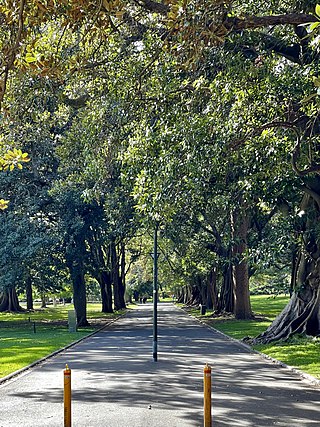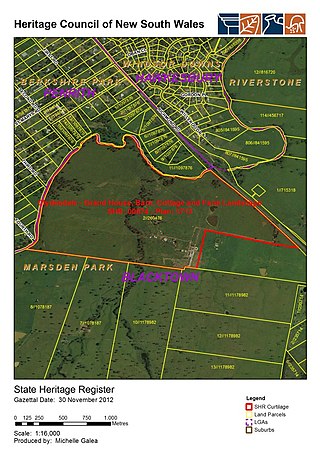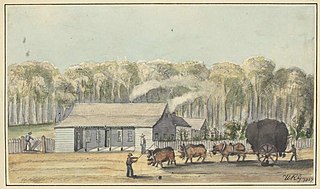
The Domain is a heritage-listed 34-hectare (84-acre) area of open space on the eastern fringe of the Sydney central business district, in the City of Sydney local government area of New South Wales, Australia. Separating the central business district from Woolloomooloo, The Domain adjoins the Royal Botanic Garden and is managed by The Royal Botanic Gardens and Domain Trust, a division of the NSW Office of Environment and Heritage, an agency of the Government of New South Wales. The Domain is used as a venue for outdoor concerts, open-air events, large political gatherings and rallies, as well as being used daily by the people of Sydney for exercise and relaxation. Along with the Royal Botanic Garden, The Domain was added to the New South Wales State Heritage Register on 2 April 1999.

Wahroonga railway station is a heritage-listed railway station located on the North Shore line, serving the Sydney suburb of Wahroonga. The station is located in the Ku-ring-gai Council local government area of New South Wales, Australia. It is served by Sydney Trains T1 North Shore line services. It was built from 1890 to 1910 by E. Pritchard & Co., contractor. It is also known as Wahroonga Railway Station group and Pearce's Corner; Noonan's Platform. The property was added to the New South Wales State Heritage Register on 2 April 1999.

Austinmer railway station is a heritage-listed railway station located on the South Coast railway line in New South Wales, Australia. It serves the northern Wollongong suburb of Austinmer. It was added to the New South Wales State Heritage Register on 2 April 1999.

Katoomba railway station is a heritage-listed railway station located on the Main Western line in Katoomba, New South Wales, Australia. It serves the Blue Mountains town of Katoomba opening on 2 February 1874 as Crushers, being renamed Katoomba on 9 July 1877.

Picton is a small town in the Macarthur Region of New South Wales, Australia, in the Wollondilly Shire, in south-western Sydney. The town is located approximately 90 kilometres south-west of the Sydney CBD, close to Camden and Campbelltown. It is also the administrative centre of Wollondilly Shire.

The Lennox Bridge is a heritage-listed sandstone single arch bridge across the Parramatta River, located in Parramatta in Western Sydney, New South Wales, Australia. The bridge was designed by and built under the supervision of David Lennox, the first Colonial Superintendent of Bridges using convict labour between 1836 and 1839. The Lennox Bridge is the third oldest surviving masonry bridge in New South Wales. The bridge carries Church Street, the main north-south street of Parramatta's central business district. It was added to the New South Wales State Heritage Register on 2 April 1999.
The Victoria Bridge is a heritage-listed timber trestle truss road bridge across the Stonequarry Creek, located at Prince Street in the south-western Sydney town of Picton in the Wollondilly Shire local government area of New South Wales, Australia. The bridge is owned by Transport for NSW, an agency of the Government of New South Wales. The bridge is also known as the Victoria Bridge over Stonequarry Creek. It was added to the New South Wales State Heritage Register on 20 June 2000. Designed by Percy Allan and opened on 7 October 1897, Victoria Bridge employs Allan trusses and was built by C. J. Ford of Sydney.
Fernhill is a heritage-listed former chicken hatchery, plant nursery, guest house, farm, residence, stone mason's yard and piggery and now residence and horse stud located at 1041 Mulgoa Road, in the western Sydney suburb of Mulgoa in the City of Penrith local government area of New South Wales, Australia. Completed in c. 1840 as a residence for Captain William Cox and family, the house was completed in the Old Colonial Greek Revival style with its design attributed to either Mortimer Lewis, John Verge or Francis Clarke. The property is privately owned. It was added to the New South Wales State Heritage Register on 2 April 1999.

Clydesdale is a heritage-listed homestead and former seminary and missionary school (1859–71) and wartime hospital (1942–44) at 1270 Richmond Road, Marsden Park, City of Blacktown, New South Wales, Australia. It was built from 1823 to 1885. It is also known as Lang's Farm; the northern half is also known as Echovale. It was added to the New South Wales State Heritage Register on 2 April 1999.

The Bungarribee Homestead Site is a heritage-listed archaeological site at the location of the former Bungarribee Homestead. The site is located at Doonside Road, Doonside, City of Blacktown, Sydney New South Wales, Australia. It was added to the New South Wales State Heritage Register on 8 December 2000.

Bella Vista is a heritage-listed residence at Elizabeth Macarthur Drive, Bella Vista, The Hills Shire, New South Wales, Australia. It was built from 1830 to 1960. It is also known as Kings Langley, Stock Farm, Seven Hills Farm and Bella Vista Farm. The property is owned by The Hills Shire Council and was added to the New South Wales State Heritage Register on 2 April 1999.

Rusten House, now known as Rusten House Art Centre, is a heritage-listed former hospital and nurses' dormitory at Antill Street, Queanbeyan, Queanbeyan-Palerang Region, New South Wales, Australia. It was designed by W. H. Downey and built from 1859 to 1862 by Daniel Jordan and Gibson. It is the Old Queanbeyan Hospital and the Nurses Dormitory. It now hosts local and touring exhibitions as well as community and private events. It is owned by the Queanbeyan-Palerang Regional Council. It was added to the New South Wales State Heritage Register on 2 April 1999.
Mayfield is a heritage-listed homestead complex at Mayfield Road, Lower Boro, Queanbeyan-Palerang Region, New South Wales, Australia. It was added to the New South Wales State Heritage Register on 18 November 1999.
Vineyard Haven is a heritage-listed landscape and archaeological site at the location of a former residence and vineyard at 1 Forest Road, New Italy, Richmond Valley Council, New South Wales, Australia. It was established from 1882. It was added to the New South Wales State Heritage Register on 10 December 2004.

The Ryde Pumping Station is a heritage-listed pumping station and offices located at Victoria Road, West Ryde, New South Wales, Australia. It was built from 1891 to 1921 by William Adams & Co. Ltd., State Monier Works, Refshaw & O'Brien. It is also known as Ryde Pumping Station and site, WP005 and West Ryde Pumping Station. The property is owned by Sydney Water. It was added to the New South Wales State Heritage Register on 15 November 2002.

Hambledon Cottage is a heritage-listed former residence and now house museum at 47 Hassall Street, Harris Park, City of Parramatta, Sydney, New South Wales, Australia. The cottage was built from 1821 to 1825, with the initial section being designed by Henry Kitchen. It is also known as Firholme, Valley Cottage and Macarthur Cottage. The property is owned by Parramatta City Council. It was added to the New South Wales State Heritage Register on 21 September 2012.

The Hassall and Jefferis Cottages are a heritage-listed former inn, coach staging post and children's home dormitory and now residence at Old South Road, Mittagong, Wingecarribee Shire, New South Wales, Australia. It was built from 1827 to 1842 by George Cutter and William Sherwin. It is also known as Cutter's Inn and Cottage No. 8 and Cottage No. 11. It is a surviving feature of the institution variously known as the Mittagong Training School for Boys and Mittagong Farm Home, State Ward Home or Children's Home, although it predated the facility. It was added to the New South Wales State Heritage Register on 2 April 1999.

Jarvisfield is a heritage-listed former pastoral property and now golf course at Old Hume Highway, Picton, Wollondilly Shire, New South Wales, Australia. It was designed by William Weaver, architect-engineer, and built from 1815 to 1864. It is also known as Wilton. The property is owned by the Wollondilly Shire Council. It was added to the New South Wales State Heritage Register on 2 April 1999.
Windmill Hill is a heritage-listed former farm and now water catchment area located at Wilton Road in the outer south-western Sydney settlement of Appin in the Wollondilly Shire local government area of New South Wales, Australia. It was built from 1820 to 1950. It is also known as Windmill Hill Group, including Ruins, North Farm, Middle Farm aka Larkin Farm and Windmill Hill, South Farm and Steven's Homestead. The property is owned by Water NSW. It was added to the New South Wales State Heritage Register on 27 June 2014.

Hadley Park is a heritage-listed former Aboriginal land, farm, dairy and gravel quarry and now unused building at 14-278 Old Castlereagh Road, Castlereagh, City of Penrith, New South Wales, Australia. It was built from 1803 to 1812. It was added to the New South Wales State Heritage Register on 20 April 2018.















